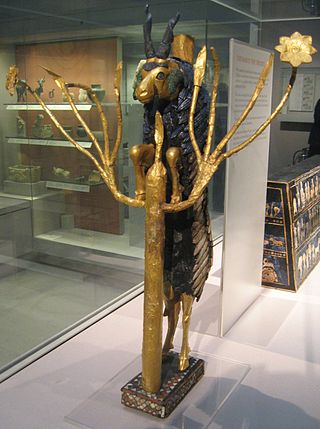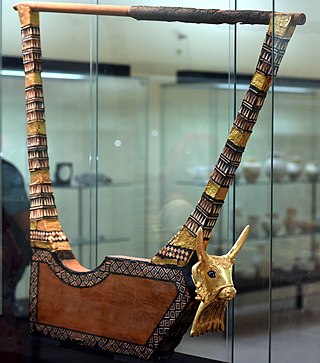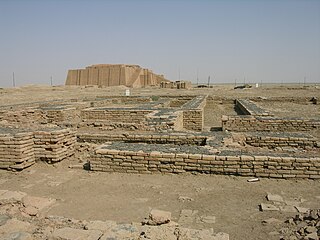Ur was an important Sumerian city-state in ancient Mesopotamia, located at the site of modern Tell el-Muqayyar in south Iraq's Dhi Qar Governorate. Although Ur was once a coastal city near the mouth of the Euphrates on the Persian Gulf, the coastline has shifted and the city is now well inland, on the south bank of the Euphrates, 16 km (10 mi) from Nasiriyah in modern-day Iraq. The city dates from the Ubaid period circa 3800 BC, and is recorded in written history as a city-state from the 26th century BC, its first recorded king being Mesannepada.
Eridu was a Sumerian city located at Tell Abu Shahrain, also Abu Shahrein or Tell Abu Shahrayn, an archaeological site in southern Mesopotamia. It is located in Dhi Qar Governorate, Iraq near the modern city of Basra. Eridu is traditionally believed to be the earliest city in southern Mesopotamia based on the Sumerian King List. Located 12 kilometers southwest of the ancient site of Ur, Eridu was the southernmost of a conglomeration of Sumerian cities that grew around temples, almost in sight of one another. The city gods of Eridu were Enki and his consort Damkina. Enki, later known as Ea, was considered to have founded the city. His temple was called E-Abzu, as Enki was believed to live in Abzu, an aquifer from which all life was believed to stem. According to Sumerian temple hymns another name for the temple of Ea/Enki was called Esira (Esirra).
"... The temple is constructed with gold and lapis lazuli, Its foundation on the nether-sea (apsu) is filled in. By the river of Sippar (Euphrates) it stands. O Apsu pure place of propriety, Esira, may thy king stand within thee. ..."
Kish is an important archaeological site in Babil Governorate (Iraq), located 80 kilometers south of Baghdad and 12 kilometers east of the ancient city of Babylon. The Ubaid period site of Ras al-Amiyah is 8 kilometers away. It was occupied from the Ubaid to Hellenistic periods. In Early Dynastic times the city's patron deity was Ishtar with her consort Ea. Her temple, at Tell Ingharra, was (E)-hursag-kalama. By Old Babylonian times the patron deities had become Zababa, along with his consort, the goddess Bau and Istar. His temple Emeteursag was at Uhaimir.
The Ubaid period is a prehistoric period of Mesopotamia. The name derives from Tell al-'Ubaid where the earliest large excavation of Ubaid period material was conducted initially in 1919 by Henry Hall and later by Leonard Woolley.

Meskalamdug was an early Sumerian ruler of the First Dynasty of Ur in the 26th century BCE. He does not appear in the Sumerian King List, but is known from a royal cylinder seal found in the Royal Cemetery at Ur, a royal bead inscription found in Mari, both mentioning him as King, and possibly his tomb, grave PG 755 at the Royal Cemetery at Ur.

Sir Charles Leonard Woolley was a British archaeologist best known for his excavations at Ur in Mesopotamia. He is recognized as one of the first "modern" archaeologists who excavated in a methodical way, keeping careful records, and using them to reconstruct ancient life and history. Woolley was knighted in 1935 for his contributions to the discipline of archaeology. He married the British archaeologist Katharine Woolley.

Tepe Gawra is an ancient Mesopotamian settlement 15 miles NNE of Mosul in northwest Iraq that was occupied between 5000 and 1500 BC. It is roughly a mile from the site of Nineveh and 2 miles E of the site of Khorsabad. It contains remains from the Halaf period, the Ubaid period, and the Uruk period. Tepe Gawra contains material relating to the Halaf-Ubaid Transitional period c. 5,500–5,000 BC.

The Department of the Middle East, numbering some 330,000 works, forms a significant part of the collections of the British Museum, and the world's largest collection of Mesopotamian antiquities outside Iraq. The collections represent the civilisations of the ancient Near East and its adjacent areas.

The Ram in a Thicket is a pair of figures excavated at Ur, in southern Iraq, which date from about 2600–2400 BC. One is in the Mesopotamia Gallery in Room 56 of the British Museum in London; the other is in the University of Pennsylvania Museum in Philadelphia, USA.
Tell Uqair is a tell or settlement mound northeast of Babylon and about 50 miles (80 km) south of Baghdad in modern Babil Governorate, Iraq.

The Lyres of Ur or Harps of Ur is a group of four string instruments excavated in a fragmentary condition at the Royal Cemetery at Ur in modern Iraq from 1922 onwards. They date back to the Early Dynastic III Period of Mesopotamia, between about 2550 and 2450 BC, making them the world's oldest surviving stringed instruments. Carefully restored and reconstructed, they are now divided between museums in Iraq, the United Kingdom, and the United States.
Imports to Ur reflect the cultural and trade connections of the Sumerian city of Ur. During the period of the Early Dynastic III royal cemetery, Ur was importing elite goods from geographically distant places. These objects include precious metals such as gold and silver, and semi-precious stones, namely lapis lazuli and carnelian. These objects are all the more impressive considering the distance from which they traveled to reach Mesopotamia and Ur specifically.

The art of Mesopotamia has survived in the record from early hunter-gatherer societies on to the Bronze Age cultures of the Sumerian, Akkadian, Babylonian and Assyrian empires. These empires were later replaced in the Iron Age by the Neo-Assyrian and Neo-Babylonian empires. Widely considered to be the cradle of civilization, Mesopotamia brought significant cultural developments, including the oldest examples of writing.

Ennigaldi-Nanna's museum is the earliest known public museum. It dates to circa 530 BCE. The curator was Ennigaldi, the daughter of Nabonidus, the last king of the Neo-Babylonian Empire. It was in the state of Ur, in the modern-day Dhi Qar Governorate of Iraq, roughly 150 metres (490 ft) southeast of the famous Ziggurat of Ur.

Ehursag is a Sumerian term meaning "house of the mountains".

Tell al-'Ubaid is a low, relatively small tell west of nearby Ur in southern Iraq's Dhi Qar Governorate. The majority of the remains are from the Chalcolithic Ubaid period, for which Tell al-'Ubaid is the type site, with an Early Dynastic temple and cemetery at the highest point. It was a cult center for the goddess Ninhursag.

The Tell al-'Ubaid Copper Lintel or Imdugud Relief is a large copper panel found at the ancient Sumerian city of Tell al-'Ubaid in southern Iraq. Excavated by the English archaeologist Henry Hall in 1919, the frieze is one of the largest metal sculptures to survive from ancient Mesopotamia and is now preserved in the British Museum.

The Royal Cemetery at Ur is an archaeological site in modern-day Dhi Qar Governorate in southern Iraq. The initial excavations at Ur took place between 1922 and 1934 under the direction of Leonard Woolley in association with the British Museum and the University of Pennsylvania Museum of Archaeology and Anthropology in Philadelphia, Pennsylvania, United States.

The Bull Headed Lyre is one of the oldest string instruments ever discovered. The lyre was excavated in the Royal Cemetery at Ur during the 1926–1927 season of an archeological dig carried out in what is now Iraq jointly by the University of Pennsylvania and the British Museum. Leonard Woolley led the excavations.

A'annepada was a king of the First Dynasty of Ur, c. 2600 BCE. He was a son of Mesannepada. It is thought that his tomb may be tomb PG 580 in the Royal Cemetery at Ur.














